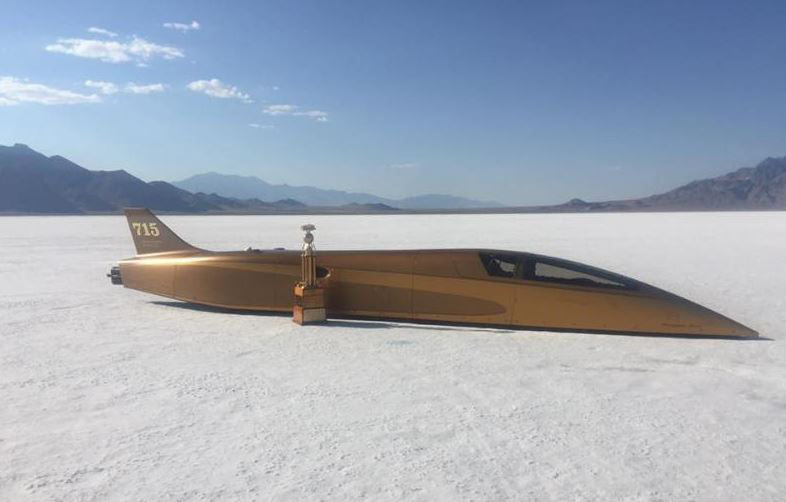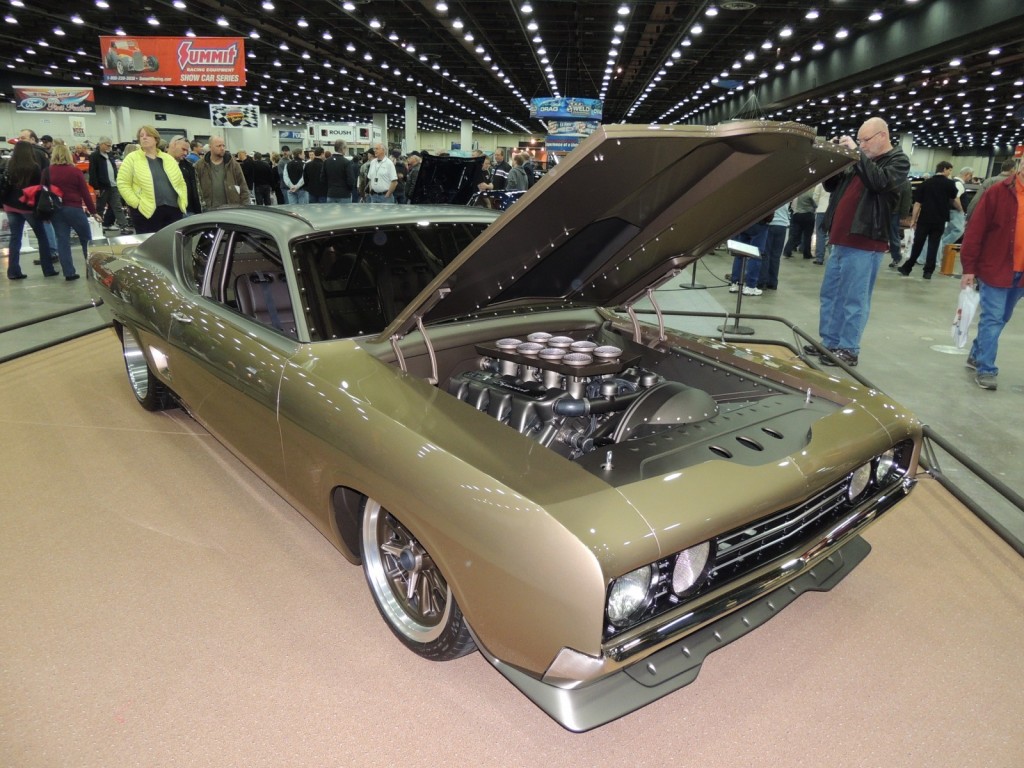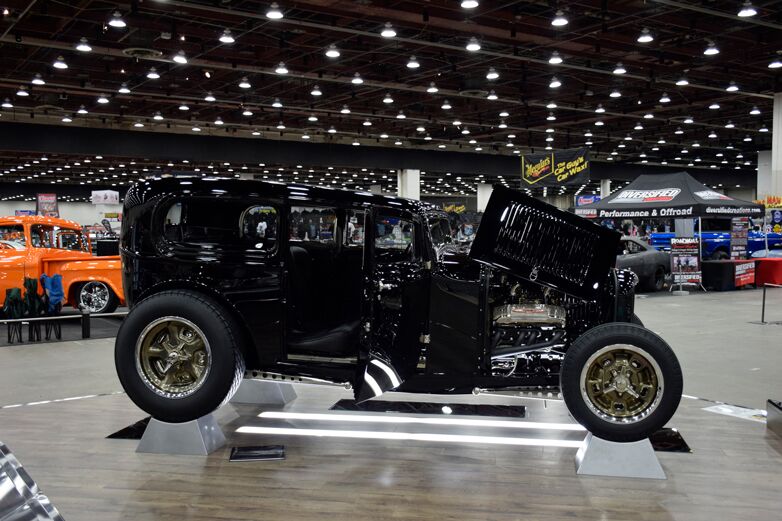George Poteet is known across the automotive universe as a gearhead with exceptional taste in hot rods and an unquenchable thirst for speed.
He’s the guy who works with some of the industry’s top builders to create award-winning show cars and, at the same time, drives blistering-fast land speed record streamliners.
His “GPT” 1932 Ford Tudor was a Ridler finalist in 2017, he’s taken home Hot Rod of the Year honors, and has scored wins at many other major hotrodding events.
For the go-fast folks, the Poteet-driven “Speed Demon” salt flats racer is considered the world’s fastest pushrod-engined, wheel-driven car—the record is currently 439.024 mph, if you want to try to break it.
We were lucky enough to speak with Mr. Poteet, and get his take on the car building/conceptualizing process, the current hotrodding trends, and the future of the automotive enthusiast hobby.
Here are some excerpts from our conversation.
What do you decide on first, the concept or the car?
I look for something that I want to build and purchase [the car] before I start on it—something I’ve wanted in the past, or something I wanted in high school. Generally, [the process] is find a car and then build it.
Then what do you like better? Do you enjoy the concept phase or the actual build the most?
Well, I like the concept and deciding what I want to do to it. The build kind of depends on the builder, their personality and whatnot—what they want to add. I give a builder a list of what I’ve decided that I want on a car and then kind of give them the freedom to add whatever is tasteful, that goes along with the theme.
Most of the guys that I deal with have been pretty easy to work with on that.
Do you ever look back at any of your builds and think “I wish I would’ve done that differently?”
[Laughing] Oh yeah, I’ve built some ugly cars. Sometimes I end up with a car and I think ‘that’s not a very good-looking car.’ Every one you do is not what we’ll call a home run. It sometimes ends up a little bit different than what it started out to be.
It’s generally the physical appearance of it—the mechanics of it, we stay pretty close to what we want. Occasionally we end up with a little bit too much of a ‘show vehicle’ to where you can’t drive it comfortably or something like that.
But [laughing] I have cars that I’d like to change some of the things I’ve done to them, yes.
What is your favorite part of the actual build process? Paint-and-body? Fabrication? Engine?
The mechanics of it. I’m not real big into the paint, fit, and finish as far as winning awards. I like to have nice paint, but the mechanics of it are most important, how everything works, and fits me for driving.
What I want to do with it, whether it’s racing, touring—the mechanics of it are the most important to me.
So it’s fair to say you’re more interested in driving a car than showing it?
I’m more interested in driving than showing, absolutely.
Is there something you see at local shows that is starting to hit mainstream? What’s the next trend?
I think the trend is, and will continue to be, affordable drivers [cars]. Right now, there’s more emphasis being placed on cars that are built for people to drive, adding parts that make an old car ride and drive comfortably.
Taking 2,000- to 3,000-mile trips in a car right now, is pretty much the thing to do. It doesn’t matter whether it’s home-built or professional-built, people want to be able to drive the cars.
[At previous shows] you saw [folks] sitting in lawn chairs, and we’ve all kind of gotten tired of that.
Drivers, with decent paint and high-quality builds as far as engineering and mechancials, is what I see happening. It’s going to happen more with folks now accepting newer models.
You mentioned newer models—Does that mean you see modern cars becoming future classics?
Well, there are plenty of cars being built now that will eventually become classics: Mustangs, Camaros, Challengers…they’re all throwbacks on the 60s muscle car. But they are modern cars that people will be able to purchase for less money than a 60s- or 70s-era car—and they’ll perform just as well.
But a lot of that depends on the [aftermarket companies] that develop products for these cars. Parts that will bolt-on and don’t require a lot of mechanical skills to install.
When you build a car, you’re changing a steering box or engine or transmission—that’s what we’ve done since the 1950s and it’s not going to end. I don’t think it’s going to end with these new cars.
So much of it depends on the industry and what the aftermarket comes out with—the availability or parts and the ease in which they’re installed.
What do think of the commentary that says kids aren’t into cars anymore?
I don’t see [hotrodding] going away, because all the manufacturers are absolutely building performers, performance-oriented cars that keep coming up with more horsepower. I certainly don’t see people working on cars going away.
So, what will the future of hotrodding look like then?
I’m pretty sold on [modern] electronics on hot rods. We have been able to set the world back for speed with a small block engine, and that’s really due now to the electronics and how we manage the computer system on it.
Even on a street car: you can buy a brand new Camaro today and just tinker with the computer a little bit and increase your performance 20 percent. And it doesn’t take a lot to do that.
I think that the [technology] will keep getting better, so the cars will run better, faster, and cleaner.
The electronic-side of a car is very, very important. They’re going to keep improving.
Me, personally, I’ve switched a lot of my cars in the past five years to LS3s with computer-operated transmissions—where you get the shift points where you want them.
It’s easier to tune a car now electronically, [laughing] than it is to gap your spark plugs and set your points.
Well, we’re about wrapped up, is there anything you want to tell the hotrodding community?
I would encourage people to build drivers rather than show cars. Show cars help us dream and scheme-out future builds, but the bottom line is you’re going to have to drive them eventually.
Build a car that you can drive.
Build a car that you can pick up the phone and order parts for—it’s easier to build a car now than it’s ever been.
One final question: Would you ever ride in an autonomous car?
[Laughing] I don’t believe I would ever ride in a self-driving car. But, then again, I said I’d never drive a six-cylinder car and I do now.
This interview occurred on March 26, 2018.




I enjoyed reading and “meeting” George Poteet in this article.
[…] the Challenger II the fastest piston-powered car in the world. (The record was previously held by George Poteet, piloting the Speed Demon […]